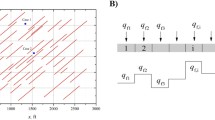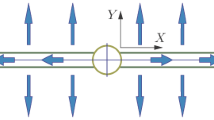Abstract
This paper considers the results of calculating transient pressure and temperature fields in a low-permeability reservoir with a hydraulic fracture taking into account the thermodynamic (Joule–Thomson and adiabatic) effects. The influence of fracture parameters (width and permeability) on the nature of time variation in the temperature of the fluid flowing into the well is analyzed. It is shown that as the pressure gradient in the fracture increases with decreasing fracture width and permeability, the contribution of the Joule–Thomson effect increases and, as a consequence, the temperature of the flowing fluid increases over time; as the fracture width and permeability increase, the adiabatic cooling effect begins to prevail, resulting in a decrease in the temperature of the flowing fluid. The considered features of the temperature field can be used to evaluate hydraulic fracture parameters.










Similar content being viewed by others
REFERENCES
R. A. Valiullin, R. F. Sharafutdinov, V. Ya. Fedotov, et al., “Using Transient Thermometry to Evaluate Wells," Neft. Khoz., No. 5, 93–96 (2015).
M. Economides, R. Oligney, and P. Valko, Unified Fracture Design: Bridging the Gap between Theory and Practice(Institute of Computer Science, Moscow–Izhevsk, 2007; Orsa Press, Texas, 2002).
A. M. Sharipov, R. F. Sharafutdinov, A. Sh. Ramazanov, and R. A. Valiullin, “Wellbore Temperature Recovery after the Cessation of Water Injection into a Hydraulically Fractured Reservoir," Vestn. Bashk. Univ. 22 (2), 301–306 (2017).
R. F. Sharafutdinov, A. A. Sadretdinov, and A. M. Sharipov, “Numerical Investigation of the Temperature Field in a Reservoir with a Hydraulic Fracture," Prikl. Mekh. Tekh. Fiz. 58(4), 153–162 (2017) [J. Appl. Mech. Tech. Phys. 58 (4), 702–709 (2017); https://doi.org/10.1134/S0021894417040150].
J. F. App, “Influence of Hydraulic Fractures on Wellbore/Sandface Temperatures during Production," in SPE Annual Tech. Conf. and Exhibit., New Orleans (USA), 30 Sept. — 2 Oct. 2013. (Soc. Petroleum Engrs, 2013). 166298.
Kh. Z. Musaleev and S. I. Mel’nikov, “Interpretation of Transient Thermal Logging in Hydraulically Fractured Wells," Neftepromysl. Delo, No. 8, 38–45 (2016).
M. Kh. Khairullin, M. N. Shamsiev, E. R. Badertdinova, et al., “Modeling the Hydrodynamic Interaction between a Reservoir and a Hydraulic Fracture," Vestn. Kazan. Tekhnol. Univ. 18(1), 326–329 (2015).
P. M. Ribeiro and R. N. Horne, “Pressure and Temperature Transient Analysis: Hydraulic Fractured Well Application," in SPE Annual Tech. Conf. and Exhibit., New Orleans (USA), 30 Sept. — 2 Oct. 2013. (Soc. Petroleum Engrs, 2013). 166222.
P. M. Ribeiro and R. N. Horne, “Detecting Fracture Growth out of Zone Using Temperature Analysis," inSPE Annual Tech. Conf. and Exhibit., Amsterdam (Netherlands), 27–29 Oct. 2014. (Soc. Petroleum Engrs, 2014). 170746.
K. Aziz and A. Settari, Mathematical Modeling of Reservoir Systems (Institute of Computer Science, Moscow–Izhevsk, 2004) [Russian translation].
A. P. Skibin and V. V. Chervyakov, “Finite Element Method Based on Control Volume Integration for Two-Dimensional Nonstationary Elliptical Problems," Izv. Akad. Nauk. Energetika, No. 1, 142–151 (1995).
D. A. Mustafina, “Finite Element/Control Volume Method for Studying Non-Isothermal Filtration Processes in Regions with Complex Geometry," Candidate’s Dissertation (Ufa, 2010).
V. M. Verzhbitskii, Fundamentals of Numerical Methods (Vysh. Shk., Moscow, 2002) [in Russian].
K. S. Basniev, I. N. Kochina, and V. M. Maksimov,Underground Fluid Mechanics (Nedra, Moscow, 1993) [in Russian].
A. Sh. Ramazanov, Theoretical Foundations of Wellbore Thermometry (Bashkir State University, Ufa, 2017) [in Russian].
Author information
Authors and Affiliations
Corresponding author
Additional information
Translated from Prikladnaya Mekhanika i Tekhnicheskaya Fizika, 2021, Vol. 62, No. 2, pp. 160–173.https://doi.org/10.15372/PMTF20210216.
Rights and permissions
About this article
Cite this article
Sharafutdinov, R.F., Davletshin, F.F. NUMERICAL STUDY OF NON-ISOTHERMAL FILTRATION OF COMPRESSIBLE FLUID IN A LOW-PERMEABILITY RESERVOIR WITH A HYDRAULIC FRACTURE. J Appl Mech Tech Phy 62, 317–328 (2021). https://doi.org/10.1134/S0021894421020164
Received:
Published:
Issue Date:
DOI: https://doi.org/10.1134/S0021894421020164




